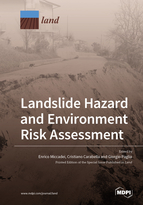Landslide Hazard and Environment Risk Assessment
A special issue of Land (ISSN 2073-445X).
Deadline for manuscript submissions: closed (30 September 2021) | Viewed by 47561
Special Issue Editors
Interests: geological and geomorphological mapping; Quaternary geology; tectonic geomorphology; geomorphology and climate change; landslide hazard; hazard and risk assessment; geotourism; engineering geology
Interests: geological and geomorphological mapping; geographic information systems; tectonic geomorphology; hazard assessment; landslides; floods; early warning systems
Interests: geological and geomorphological mapping; tectonic geomorphology; geomorphology and climate change; geographic information systems; landslides; hazard assessment
Special Issue Information
Dear Colleagues,
Landslides are global geomorphological phenomena occurring in all geographic regions in response to a wide range of triggering factors. Landsliding is linked to the combination of geological, geomorphological, and climatic factors in response to trigger mechanisms mostly represented by heavy rainfall events, seismicity, or human action. Landslides directly and indirectly impact a territory, causing fatalities and huge socioeconomic losses also due to environmental degradation and rapid population growth, which requires correct land use policies and best practices for long-term risk mitigation and reduction. In this context, geomorphological field activities, satellite remote sensing, and numerical modeling offer effective support for mapping and monitoring the activity of landslides at both the local and regional scales.
We would like to invite you to participate in this Special Issue, which will focus primarily on such innovative methods to accurately investigate landslide phenomena providing useful products to characterize landslide risk management. All landslide types are considered, from fast rockfalls to debris flows and from slow-moving slides to very rapid rock avalanches. All climatic and geographical scales are considered, from the local to the global, including individual and multiple slope failures.
Contribution to this Special Issue will provide scientific tools for the preparation and optimal use of landslide maps, landside prediction models, landslide susceptibility maps, and the design of risk mitigation measures.
Submissions are encouraged to cover a broad range of topics on the various applications of different techniques, which may include, but are not limited to, the following topics: (i) analysis of landslide conditioning and triggering factors, (ii) geomorphological analysis and GIS mapping, (iii) landslide hazard mapping, (iv) landslide susceptibility mapping, (v) remote sensing techniques for the definition of vulnerability and characterization of elements at risk, (vi) investigation and monitoring of landslide dynamics, (vii) implementation of sustainable territorial planning, and (viii) design and implementation of smart adaptation measures to reduce risks, such as early warning systems.
Prof. Dr. Enrico Miccadei
Dr. Cristiano Carabella
Dr. Giorgio Paglia
Guest Editors
Manuscript Submission Information
Manuscripts should be submitted online at www.mdpi.com by registering and logging in to this website. Once you are registered, click here to go to the submission form. Manuscripts can be submitted until the deadline. All submissions that pass pre-check are peer-reviewed. Accepted papers will be published continuously in the journal (as soon as accepted) and will be listed together on the special issue website. Research articles, review articles as well as short communications are invited. For planned papers, a title and short abstract (about 100 words) can be sent to the Editorial Office for announcement on this website.
Submitted manuscripts should not have been published previously, nor be under consideration for publication elsewhere (except conference proceedings papers). All manuscripts are thoroughly refereed through a single-blind peer-review process. A guide for authors and other relevant information for submission of manuscripts is available on the Instructions for Authors page. Land is an international peer-reviewed open access monthly journal published by MDPI.
Please visit the Instructions for Authors page before submitting a manuscript. The Article Processing Charge (APC) for publication in this open access journal is 2600 CHF (Swiss Francs). Submitted papers should be well formatted and use good English. Authors may use MDPI's English editing service prior to publication or during author revisions.
Keywords
- landslide dynamics, mechanisms, and processes
- landslide hazard mapping
- geomorphological mapping
- geomorphology and climate change
- remote sensing and GIS analysis
- landslide susceptibility map
- landslide monitoring
- risk assessment
- remedial or preventive measures
- territorial planning








